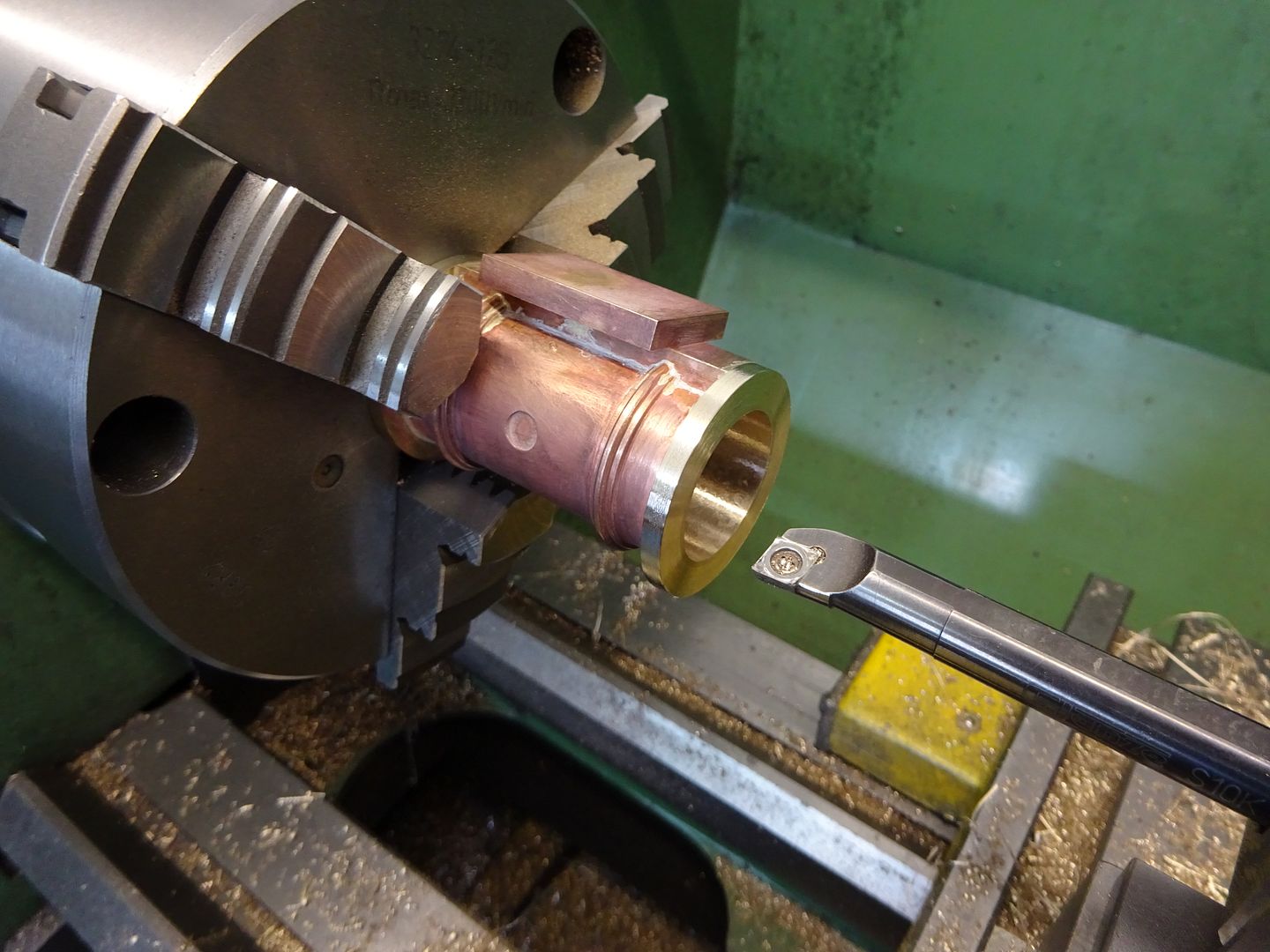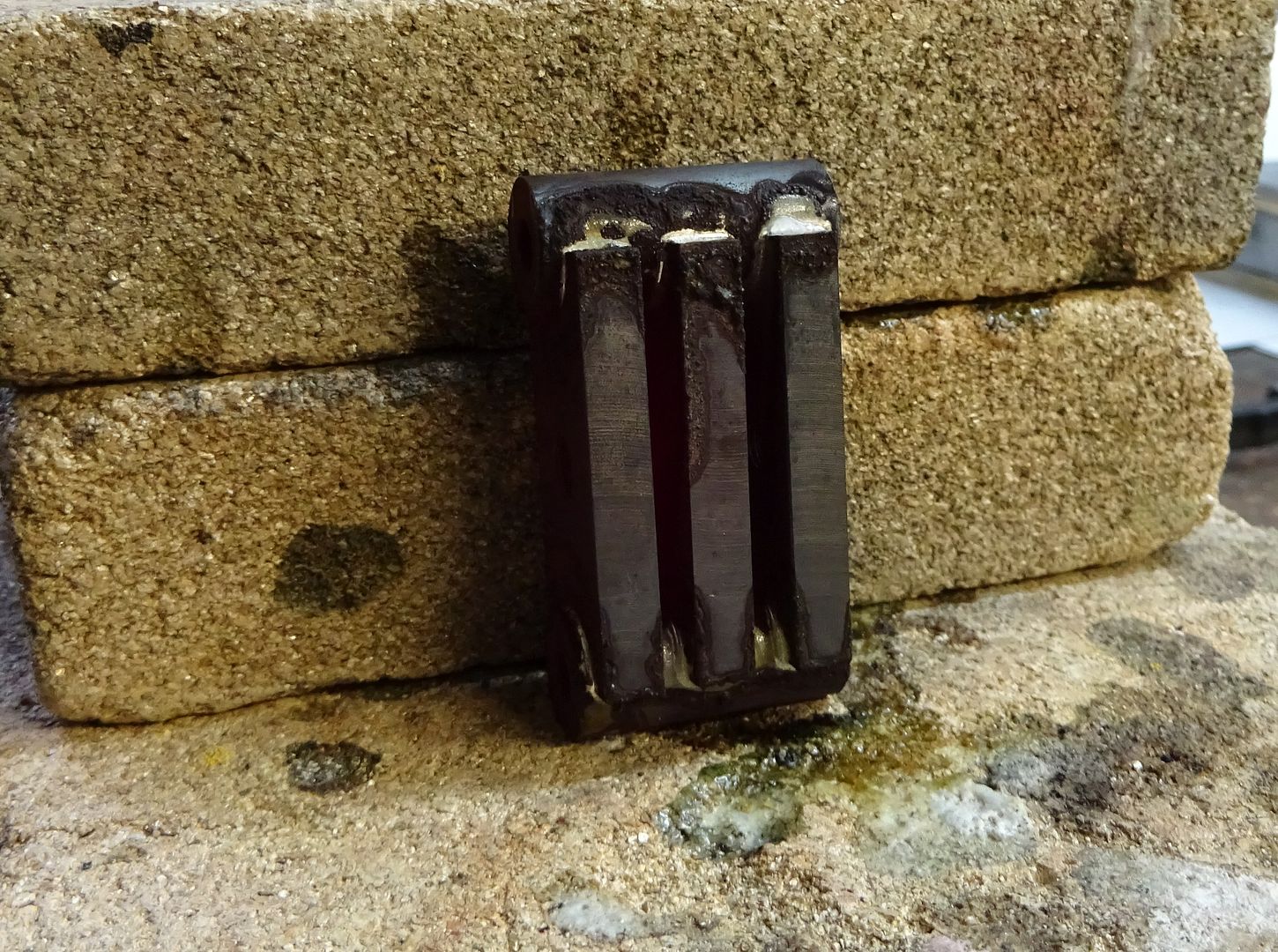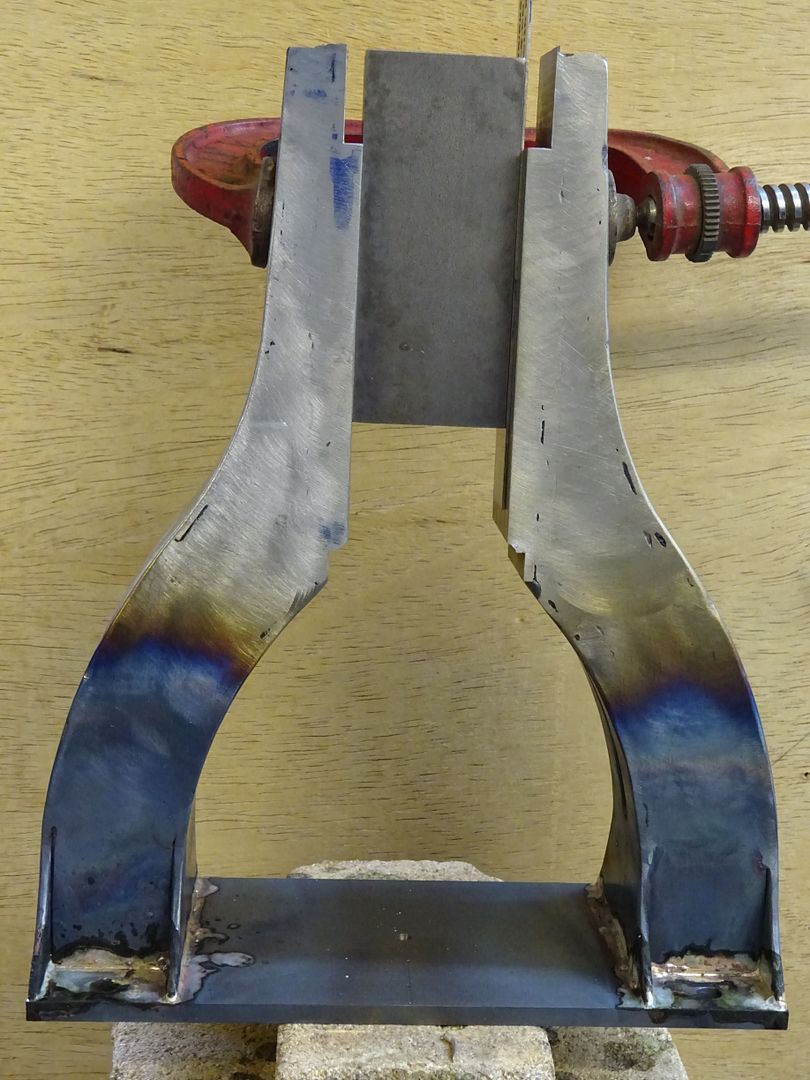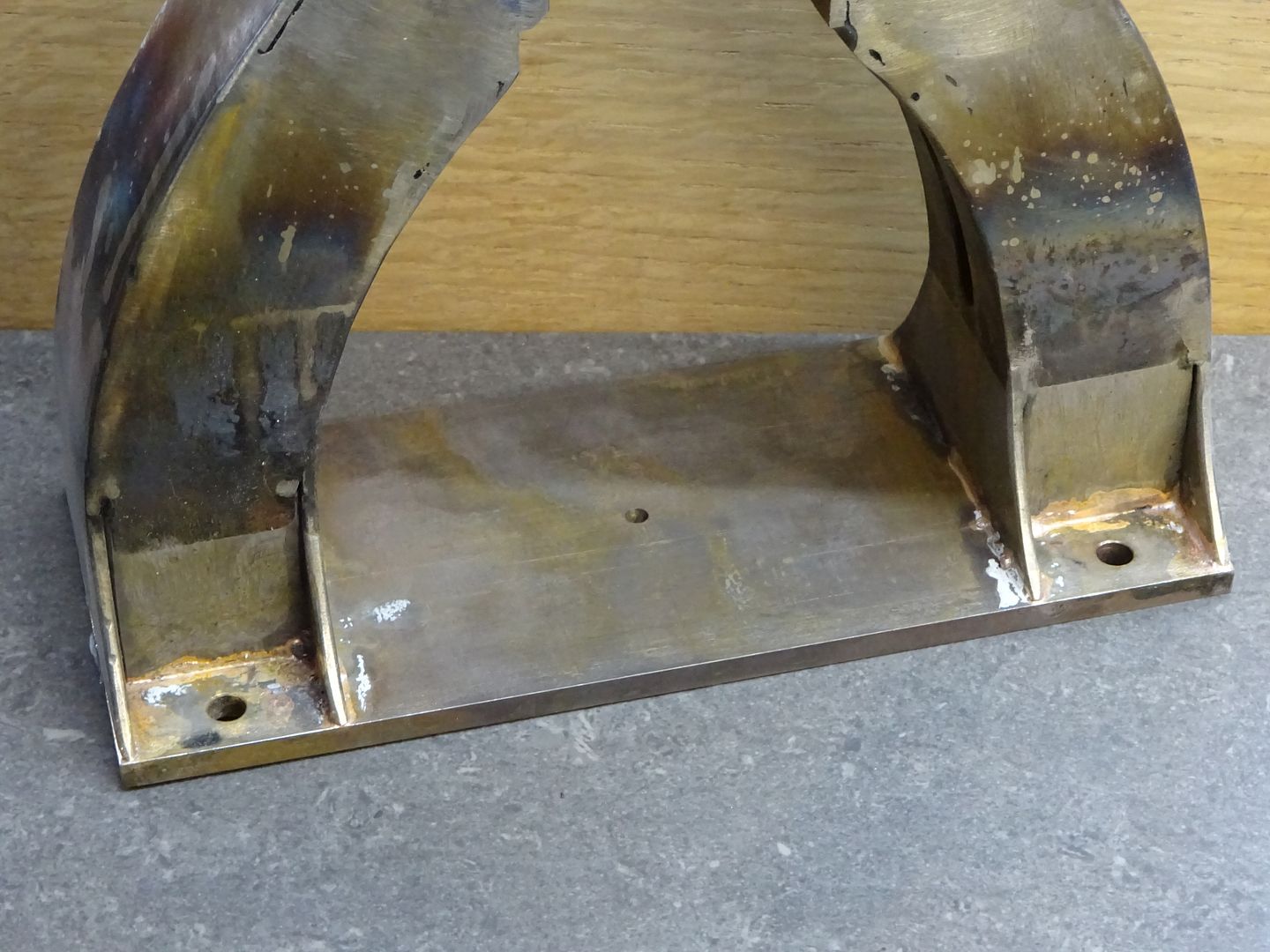Pickling brass after silver soldering.
| Robin Graham | 22/04/2020 23:25:10 |
| 1089 forum posts 345 photos | I'm planning on doing something in brass which will involve quite a bit of silver soldering. In the past when silver soldering brass I've been able to polish off the 'scale' - that pink coating [presumably Cu(I) oxide?] mechanically, but on this project it will likely be too tedious/fiddly. So I'm wondering about chemical methods. I had a look round and found a post on a US website which recommended a mixture of Sparex pickle and hydrogen peroxide. From the MSDS it seems that Sparex is just sodium bisulphate, which I think I can buy on eBay, and I have hydrogen peroxide. The recipe I saw gives proportions, but doesn't specify the hydrogen peroxide concentration - just what you get from the drugstore! I'm sure that there will be forum members who have trodden this path before me - any advice? Robin. |
| Bob Stevenson | 23/04/2020 00:16:45 |
| 579 forum posts 7 photos | You can use citric acid quite safely....some people just buy a bottle of lemon juice at their nearest supermarket, but that might be difficult currently..... Dry citric acid is sold in small packets by Cup-Alloys and works well, although you should note that it will quickly give the brass a matt finish, although this can be quite attractive for some uses. |
| IanT | 23/04/2020 00:42:46 |
| 2147 forum posts 222 photos | I buy food grade Citric Acid on eBay - I've just found a 1.6Kg pack of citric powder for £7.50 including shipping in UK. It's used in Indian cooking I believe. Regards, IanT
|
| JasonB | 23/04/2020 06:56:49 |
25215 forum posts 3105 photos 1 articles | Acids that I have used will remove flux and scale but leave the part "pink" maybe those mixtures you mention don't attack the other metals (zinc) and leave the copper on the surface and you get a "brass" surface rather than a "copper" one, just look at any freshly pickled copper and it is pink. Fine wire brush after rinsing seems to get rid of te pink for me, bead blasting is ideal if you have it.
Edited By JasonB on 23/04/2020 07:33:27 |
| Bo'sun | 23/04/2020 09:02:21 |
| 754 forum posts 2 photos | Home brew shops are also a good source for citric acid crystals. Used for sterilising I believe. You might even get the bug for home brewing. What's not to like. |
| JasonB | 23/04/2020 09:14:34 |
25215 forum posts 3105 photos 1 articles | Can those suggesting using citric acid confirm that they don't get a "pink" cast on the part after pickling as when I use it the brass parts comes out pink, same with other stronger acids. Typical bronze and brass fabrication after soldering
Edited By JasonB on 23/04/2020 09:18:06 |
| SillyOldDuffer | 23/04/2020 09:20:07 |
| 10668 forum posts 2415 photos | Posted by Robin Graham on 22/04/2020 23:25:10:
I'm planning on doing something in brass which will involve quite a bit of silver soldering. In the past when silver soldering brass I've been able to polish off the 'scale' - that pink coating [presumably Cu(I) oxide?] mechanically, but on this project it will likely be too tedious/fiddly. So I'm wondering about chemical methods. I had a look round and found a post on a US website which recommended a mixture of Sparex pickle and hydrogen peroxide. From the MSDS it seems that Sparex is just sodium bisulphate, which I think I can buy on eBay, and I have hydrogen peroxide. The recipe I saw gives proportions, but doesn't specify the hydrogen peroxide concentration - just what you get from the drugstore! I'm sure that there will be forum members who have trodden this path before me - any advice? Robin. I doubt the strength of the Hydrogen Peroxide matters much, in the UK it was sold at 10vol, 20vol, or 30vol concentrations. In all those forms it's a mild bleach and effective anti-septic. Sodium Bisulphate, 'Half Neutralised Sulphuric Acid', is a moderately fast acting pickle and cheap to buy. It's not as quick as Sulphuric Acid, but it's cheaper and faster than Citric Acid. It's just the stuff for Copper. Safe to handle and can be poured down an ordinary drain when finished. But I don't think it's a good idea to use Sodium Bisulphate (or any other acid) on Brass. Although it happily removes scale and oxide, it also dissolves Zinc. As brass is a Copper/Zinc alloy, removing Zinc leaves a pink porous copper layer behind. This is the dreaded de-zincification that stops brass being used to make boilers and gradually damages water fittings in some places. I'm not sure what the purpose of adding Peroxide is. I notice customers often comment adversely about Sparex solution having a brown colour that makes it difficult to see what its doing to jewellery. Just a guess, but adding peroxide (bleach) might just be to remove the brown colour. In which case, you add however much peroxide is needed, and it's unecessary for ordinary pickling, Wikipedia says the professionals don't use dilute acids to pickle brass. Much more exciting, they do it with 'concentrated sulfuric and nitric acid mixed with sodium chloride and soot.' Although the mixture is hideously aggressive, it doesn't attack Copper or Zinc. Don't try it at home folks! I wonder if Cup Alloys are awake yet - they know about this stuff! Dave
|
| mick | 23/04/2020 16:58:28 |
| 421 forum posts 49 photos | Aldi Lime scale remover, works a treat! |
| Chris Gunn | 23/04/2020 19:43:12 |
| 459 forum posts 28 photos | Jason, I just bought some Citric acid to give it a try, and everything came out pink, just as your picture. I was picking my clacks and injector prior to the annual steam test, and it removed the lime scale really fast, but left the pink colour. Chris Gunn |
| Bob Stevenson | 23/04/2020 20:26:19 |
| 579 forum posts 7 photos | citric acid does indeed impart a pinkish tinge to brass parts......I assume that this is caused by the acid releasing the copper particles near to the surface. It's quite easy to remove by a quick rub with fine wire wool.
More serious in my view is the change to the surface finish....citric imparts a fine matt finish to polished brass in a very short time, perhaps just five minutes or so. On the other hand, this could be useful as it resembles a very fine blasted finish which is very difficut otherwise in a small domestic workshop. I may well use this finish for the inside of the plates on my current clock build. |
| fizzy | 23/04/2020 20:47:30 |
1860 forum posts 121 photos | I absolutely do not put brass into the pickling tank. The pink 'residue' isnt a residue at all, its the inactive copper left over when the Zinc has been removed. The only way to get it back to colour is to abrade the Copper layer away until you hit the brass underneath. I tried every way to avoid this but found none - citric acid does the same as other acids, it just takes a lot longer. All of our brass products are now de-scaled by hand. If anyone has a genuine proven alternative I will be the first to embrace it as I hate brass dust!
|
| fizzy | 23/04/2020 20:50:22 |
1860 forum posts 121 photos | This is an early example of a tank which had been lightly pickled, never could get rid of the hint of pink |
| fizzy | 23/04/2020 20:56:59 |
1860 forum posts 121 photos | |
| Neil Wyatt | 23/04/2020 21:16:51 |
19226 forum posts 749 photos 86 articles | Fizzy's right, the pink is caused by de-zincification of the surface. You can get round it by being quick and using a blunt instrument (old screwdriver) to get the worst of the pckle off. The part will then polish back quite easily. In the old days scouring powder and elbow grease (Vim) was recommended. Neil
|
| Paul Kemp | 24/04/2020 00:13:52 |
| 798 forum posts 27 photos | Jason / Others, What is your experience of pickling steel parts in either citric acid or brick cleaner? I have a few steel fabrications to silver solder shortly. Previously I have never tried pickling steel parts and have cleaned by hand but as the OP one of the fabrications will be a bit of pain to clean by hand after! Sorry to hijack but I think the original question has been answered. Thanks, Paul. |
| JasonB | 24/04/2020 07:06:01 |
25215 forum posts 3105 photos 1 articles | I did see mention of adding ammonia to the citric acid to bring the Ph down to 9 but have not tried it. Yes the pink will abrade off but just like the OP's original problem it can be hard to get at all the surfaces if it's a complicated fabrication so not easy to wire brush or buff up. Paul I do all my steel in brick cleaner and it works well at getting the black scale layer off and removing the more stubborn Tenacity flux. It will leave a matt grey surface and if you leave the part too long can start to eat into it but I've only had that once on some PGMS. If you have used the same liquid for non ferrous then it can leave a coppery deposit but that comes off easily. Dry well after rinsing and if it's going to hang about use some WD40 or similar as the bare steel will rust. These two give an idea of the matt surface
And the tide mark part way up this shows where the acid was active, probably needed a little longer as there is still some traces of white flux
|
| AdrianR | 24/04/2020 08:00:24 |
| 613 forum posts 39 photos | After silver soldering our boxes and ashtrays from gilding metal at school, we used a handful of damp crushed pumice and rub the scale off. For corners either an orange stick or lollypop stick to push the pumice around. I just checked on ebay, you can get pumice quite cheaply.
Adrian |
| JasonB | 24/04/2020 08:05:16 |
25215 forum posts 3105 photos 1 articles | Maybe a reminder of the OP's question before more suggestions of acid or abrading would save some time In the past when silver soldering brass I've been able to polish off the 'scale' mechanically, but on this project it will likely be too tedious/fiddly. So I'm wondering about chemical methods? |
| Robin Graham | 25/04/2020 00:28:39 |
| 1089 forum posts 345 photos | Thanks for replies. As Jason said, my original question was about getting the 'scale' off by non-mechanical methods, but any discussion around the general problem is welcome, to me at least. I now think that I was mistaken in assuming that the 'pink stuff' is cuprous oxide - my info came from a jewelry discussion . It seems more reasonable that it is in fact finely divided copper, resulting from dezincification of the brass, as has been suggested here. In which case I don't understand why acids, mineral (bar nitric) or organic would be effective in removing it. Copper is pretty inert (a noble metal in some classifications) - the reason nitric acid can get to it is because of its oxidative power. Maybe that's how the bisulphate/hydrogen peroxide mix works. SoD - I'm intrigued by your idea that the peroxide is there to 'bleach out' the brown colour, if that's what you meant. Generally oxidative bleaching works by breaking up organic chromophores - my own guess (and it's only a guess) is that the brown colour is more likely to be caused by suspended or colloidal metal or metal oxide particles. For the removal of flux residues, I use a hot sodium hydroxide (caustic soda) solution, maybe 10-20% That's for Tenacity 5. It works well, and is quick. I now think that there's no easy way - I just have to resign myself to spending much more time finishing than making. That's the way of things perhaps - certainly true with my attempts at woodwork, the cutting/chiselling/planing is fun, the sanding, coating, polishing etc etc isn't. But it has to be done! Robin |
| Steviegtr | 25/04/2020 00:40:29 |
2668 forum posts 352 photos | I used to have some pickling paste that I used after welding stainless steel. It was very good but always left the stainless finish dull. Apparently the stuff is banned now. Is this the same stuff for all metals. ???? Steve. |
Please login to post a reply.
Want the latest issue of Model Engineer or Model Engineers' Workshop? Use our magazine locator links to find your nearest stockist!
Sign up to our newsletter and get a free digital issue.
You can unsubscribe at anytime. View our privacy policy at www.mortons.co.uk/privacy
- *Oct 2023: FORUM MIGRATION TIMELINE*
05/10/2023 07:57:11 - Making ER11 collet chuck
05/10/2023 07:56:24 - What did you do today? 2023
05/10/2023 07:25:01 - Orrery
05/10/2023 06:00:41 - Wera hand-tools
05/10/2023 05:47:07 - New member
05/10/2023 04:40:11 - Problems with external pot on at1 vfd
05/10/2023 00:06:32 - Drain plug
04/10/2023 23:36:17 - digi phase converter for 10 machines.....
04/10/2023 23:13:48 - Winter Storage Of Locomotives
04/10/2023 21:02:11 - More Latest Posts...
- View All Topics
- Reeves** - Rebuilt Royal Scot by Martin Evans
by John Broughton
£300.00 - BRITANNIA 5" GAUGE James Perrier
by Jon Seabright 1
£2,500.00 - Drill Grinder - for restoration
by Nigel Graham 2
£0.00 - WARCO WM18 MILLING MACHINE
by Alex Chudley
£1,200.00 - MYFORD SUPER 7 LATHE
by Alex Chudley
£2,000.00 - More "For Sale" Ads...
- D1-3 backplate
by Michael Horley
Price Not Specified - fixed steady for a Colchester bantam mark1 800
by George Jervis
Price Not Specified - lbsc pansy
by JACK SIDEBOTHAM
Price Not Specified - Pratt Burnerd multifit chuck key.
by Tim Riome
Price Not Specified - BANDSAW BLADE WELDER
by HUGH
Price Not Specified - More "Wanted" Ads...
Do you want to contact the Model Engineer and Model Engineers' Workshop team?
You can contact us by phone, mail or email about the magazines including becoming a contributor, submitting reader's letters or making queries about articles. You can also get in touch about this website, advertising or other general issues.
Click THIS LINK for full contact details.
For subscription issues please see THIS LINK.
Model Engineer Magazine
- Percival Marshall
- M.E. History
- LittleLEC
- M.E. Clock
ME Workshop
- An Adcock
- & Shipley
- Horizontal
- Mill
Subscribe Now
- Great savings
- Delivered to your door
Pre-order your copy!
- Delivered to your doorstep!
- Free UK delivery!

 And after pickle, only bright brass is where I have been finish machining the part, rest is pink due to exposed copper on the surface
And after pickle, only bright brass is where I have been finish machining the part, rest is pink due to exposed copper on the surface 















 Register
Register Log-in
Log-in


